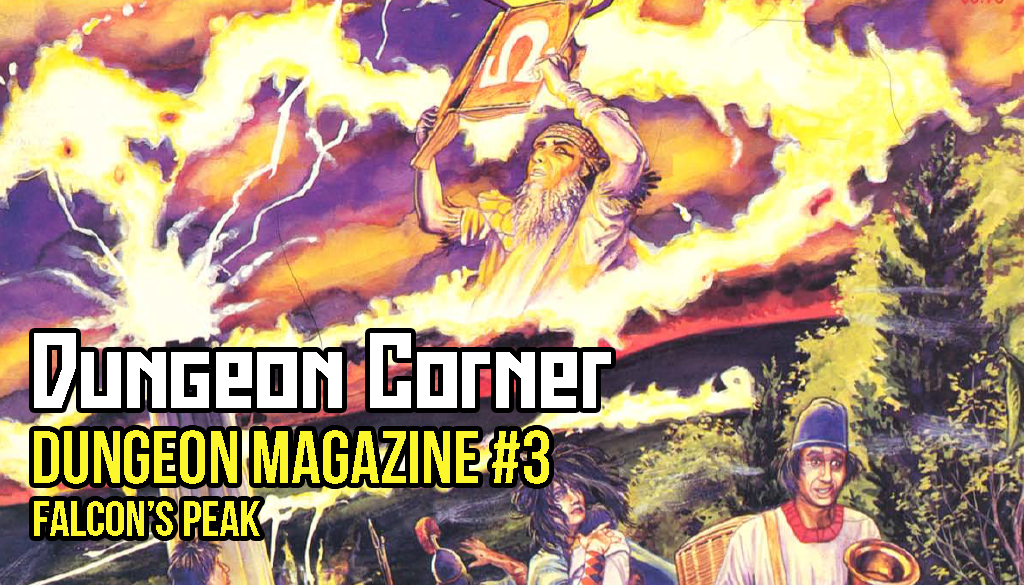Dungeon Magazine #3: Falcon’s Peak
This post originally appeared on Patreon. Patrons get access to blog posts at least a week before they appear on Loot The Room, as well as additional Patreon-exclusive content. Tiers start from £2 a month and your support helps to keep this site alive. Sign up here.
You can find the other posts in this series here.
Issue three of Dungeon Magazine contains four adventures:
-
Falcon’s Peak by David Howery
-
Blood on the Snow by Thomas M Kane
-
The Deadly Sea by Carol and Robert Pasnak
-
The Book with No End by Richard Emerich
All of the authors in this issue are new to Dungeon. All of the adventures in this issue are for AD&D and range from levels 1 to 12. I’m particularly interested in “Blood On The Snow” – an arctic adventure – and “The Deadly Sea”, the rare underwater adventure (which happens to be my favourite genre of adventure, in large part because there are so few of them).
As always we’ll start at the beginning, though, with David Howery’s “Falcon’s Peak”. This sounds like a pretty straightforward setup – a Lord is dead, he’s left treasure behind, and you intend to go and steal it. This should be simple, but the fortress holds “a new brood of evil” that may complicate matters. This adventure is designed for 5-8 characters of 1st-3rd level, and should include a thief, at least one experienced cleric, and preferably a ranger.
David Howery appears to have had a good success rate selling things to TSR, with adventures in 10 issues of Dungeon and articles in around 15 issues of Dragon. He doesn’t look to have been active much past the late 90s/early 00s, though.
The backstory here is pretty brief. An old brigand chief – Lord Falcon – had a fortress in a mountain pass that was said to hold a horrible monster to whome said warlord fed his enemies. Eventually the baronies that bordered his territory banded together to mount an assault on the fortress and overwhelmed the brigands, but Lord Falcon himself was never discovered. Rumours say that he and his family drank poison and had themselves sealed into their catacombs by retainers, but nobody knows where said catacombs are – only that they’re likely filled with treasure. The place has been abandoned for close to a century, bothered only by would-be treasure hunters who fail to return from their expeditions as often as not. And so, hearing this, the PCs decide that they should be the next group of would-be thieves to brave the fortress and seek the treasure.
The fortress is currently occupies by brigands, and they’re likely to be encountered on the journey there. They’re “the usual riffraff one sees in small gangs of this kind – dirty, crude, and vicious”. They’re also more than happy to admit that they live in the fortress if the bribe is high enough, though they’ll lie about its defences. All of them live in fear of the bandit chief Millard, a magic user who has allied his brigands with a small clan of hobgoblins. Their forces are still fairly weak and so they haven’t launched any raids on nearby settlements, but they’re hard at work reinforcing Falcon’s Peak to make it as formidable as it once was.
The fortress itself is fairly well defended, both by brigands and by hobgoblins encamped in the caves nearby, and the first challenge here is one of simply getting inside the place. Quite a lot of attention is paid to the way in which the walls of the fortress are defended and to the details of the hobgoblin caves, which actually leads directly to the catacombs. The hobgoblins haven’t yet been able to enter them due to the presence of a pair of ghouls, though I’m unsure why a warband of hobgoblins should find just two ghouls difficult to deal with. Regardless of the reason, Lord Falcon is waiting for an evil cleric to come and help him with the ghoul problem rather than deal with them himself.
Interestingly, if the PCs are only in search of the catacombs themselves, they could potentially find them without ever having to go near the fortress if they come to the hobgoblin caves first. They will have no way of knowing that the catacombs are here, but if they decide to clear the caves they’ll eventually discover them. The ghouls have partially broken into the catacombs through the back wall of the caves by “entering through the caverns and digging through the loose rock until [the catabomcs] were reached” but haven’t managed to breach them any further because they accidentally locked a door. This seems like a really silly way of stopping the ghouls from ransacking the rest of the catacboms – why can they dig through rock but not kick down a door? – but I suppose there needs to be some reason why the place is still intact. I don’t particularly like this one, though, and I wish the module was a little more inventive here.
The catacombs themselves are nicely creepy, with walls decorated with “lurid paintings” of demons carrying scythes and throwing screaming victims into a dark pit. A temple dedicated to the Grim Reaper – yes, that Grim Reaper, who is the neutral evil patron of Lord Falcon – is guarded by a bunch of human zombies and a huge ogre zombie, all carrying scythes. I find zombies a little silly, but zombies with scythes are a cool touch, and them combined with a magical idol that freezes low-HD characters in place through a fear effect could make for a really nasty encounter. This is made particularly mean by the idol also blocking a cleric’s ability to turn the zombies here, which is an additional fuck you. I’m not sure whether I like this or not, since clerics don’t get to use their turning ability all that often. It seems a little cruel to give them something to turn for once and then to say “actually no”, especially after explicitly calling out the fact that a couple of clerics would be useful to have on this adventure.
Things get a little sillier deeper in to the catacombs. One room contains a cursed scroll that turns those who read it into a scum creeper, a sort of slug-like monster about a foot long. Another room contains another such scroll that’s been utilised on a group of tomb robbers, all of whom have been turned into scum creepers. There are some “normal” scum creepers in this room but also the four thieves, all of whom still remember being human. While the normal monsters attack the PCs, the thieves “crawl onto the floor and write “WE ARE HUMAN” into the dust in one corner, using their cilia. They then frantically wave their cilia in an attempt to draw the party’s attention to the words”. This is so daft that I can’t help but laugh. It’s especially funny that, after having been turned into slugs 12 years ago, they’re grateful to be rescued but not so grateful that they don’t “consider robbing the party and escaping if the party appears rich, weak, and foolish”.
Something interesting going on in this adventure is that lots of the rooms explain things that the PCs don’t really have any way of discovering, especially at the low levels suggested for the module. One room contains a pair of skeletons, one of whom has a knife embedded in him. The GM is told that “the man’s skeleton is that of Falcon’s most trusted servant. The servant entombed everyone in the catacombs, including Falcon’s mistress, the other skeleton in the tomb. After bolting the fortress’s trap door which leads in the catacombs, the servant lay down and killed himself”. There’s simply no way for the PCs to discover this information.
I’ve written in the past about modern adventures for games like 5e and Pathfinder often containing a lot of writing like this that seems to function more like fiction for the GM to read while prepping rather than gameable information that could actually be revealed to the players. Thus far in my journey through Dungeon Magazine we haven’t seen much of it, but that’s definitely what’s happening here. The PCs could, I suppose, discover this with a speak with dead spell, but that’s a 3rd level spell in AD&D and clerics don’t get access to them until level 5, so the chances of them actually having access to this are incredibly slim. I understand the urge to include these sorts of explanations in the text of an adventure, but I actually think things are much stronger when the explanations aren’t present. If players have no way to access the information then all it does is get in the way of the GM’s ability to parse the important stuff, and players who are interested in finding an explanation will always come up with something during play that’s more interesting anyway.
The catacombs themselves have an exit at the back, a ladder climbing up through the cliff that emerges at a trapdoor in the storage room of the fortress. Much like the ghouls being unable to open a locked door earlier in the adventure, I’m a little sceptical of this entrance to the fortress. We’re told earlier that nobody has ever been able to find the entrance into the catacombs from the fortress, but it’s literally just a trapdoor in the floor of a storage chamber. Even with it being locked from below as in this case, and well concealed, it feels like somebody who was actively searching for it over hundreds of years would have find it. Either way, though, it’s very funny that the reason the bandits in the fortress haven’t currently found it is because they’ve put two big crates full of food directly on top of it.
The logic falls down a little more as we get deeper into the fortress, too. We were told earlier that the bandits aren’t really known of in the local area because they’ve been keeping a low profile while they build their strength, but that doesn’t appear to be the case when we get to the “Captives’ Room”, which contains a bunch of hostage including a noble elf from a far land, four minor officials from a nearby town (each with a 100gp reward out for them), the daughter of a wealthy spice merchant from another nearby town (500gp reward), and a gnomish assassin who the brigands are planning to ransom as soon as they can figure out who to speak to about that. It seems to me that somebody should be looking for these people, but the module entirely ignores that. Finding any of these people would be a much more interesting reason to come here than searching for the catacombs, especially as finding the catacombs can be done without ever interacting with the brigands, and I think if I were to run this I’d put these captives in a much more central position in the way I presented the adventure to the players.
In the final room of the fortress we meet, at last, the fabled monster said to live here. It’s a wight in a pit, the floor surrounded by the bones of those who have been fed to it, and the pit is accessed via a trap door in the floor of what is now Millard’s room, directly in front of the door. As with the fortress itself, it’s actually quite likely that the players could go through this whole module without ever encountering the wight.
This is the biggest weakness of the module, really. The hook the players are given – the whole reason they’re coming here – is to search for the catacombs and the treasure inside it. Once they’re there they really have no reason to go to the fortress other than that it’s there. I think if this were put in an ongoing campaign, most players would simply take the loot and run – particularly as the brigands have no real way to know who’s looted the place or who killed all the hobgoblins. It could be interesting for the players to later find out about the hostages in the fortress and be forced to come back, or Millard could do some scrying and put a bounty on their heads, but as a standalone adventure this feels a bit lacking. It’s particularly interesting to compare this to Into The Fire from issue 1, which also allows the players to obtain their initial goal without interacting with half (or more) of the adventure but which is compelling enough to make them want to keep exploring afterwards. I don’t really get the impression that that would be the case here, and this doesn’t strike me as an adventure that I’d be in a hurry to try and get to the table.




